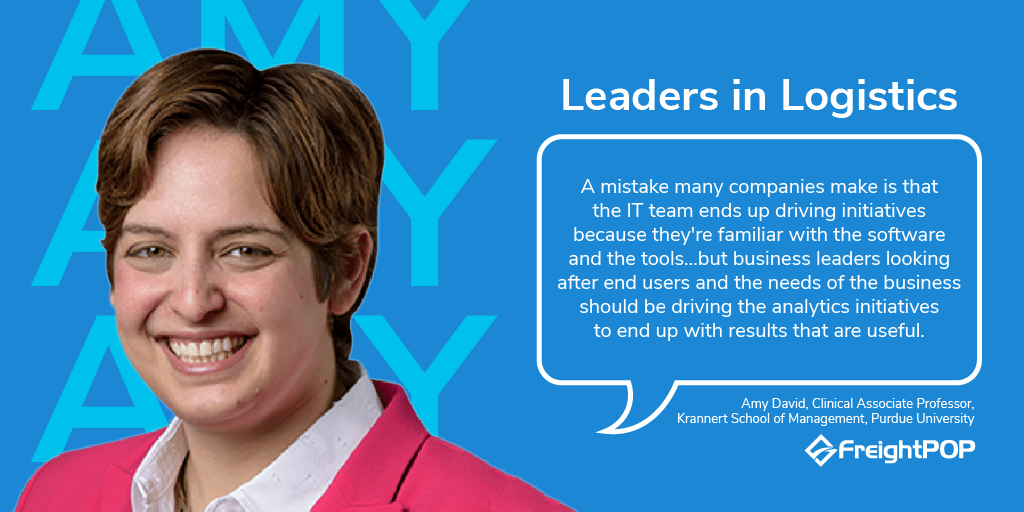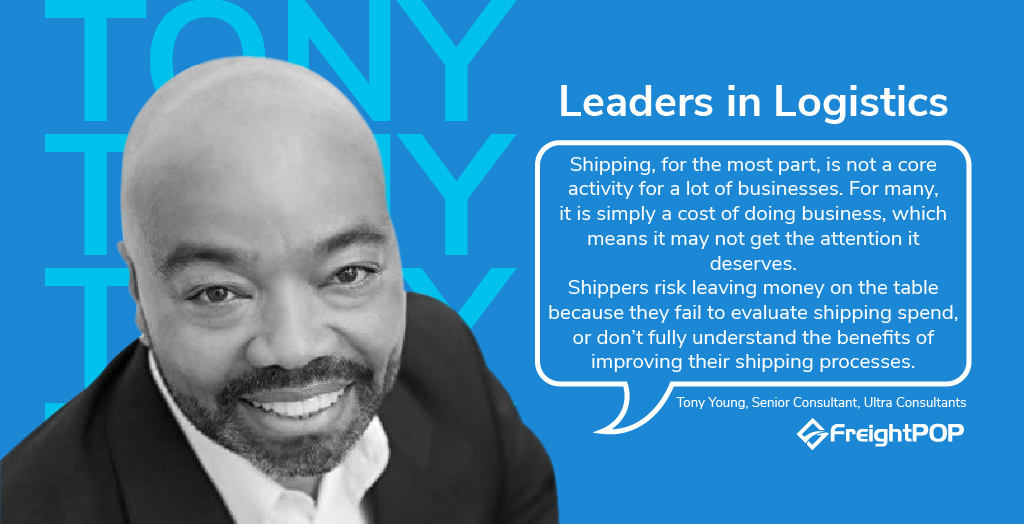Tony Young, ERP Consultant, on the Value of Digitizing Logistics
LEADERS IN LOGISTICS: Tony Young, a senior ERP consultant from Ultra Consultants shares his insight on digitizing logistics, where many shippers...
5 min read
FreightPOP : Aug 23, 2021

Digitizing logistics is a goal of many businesses, primarily for efficiency, but also to become data-driven. We ask an expert how accessible higher-level analytics are and how they can help you.
NOTE: To be featured in our ongoing Leaders in Logistics feature, reach out to our team!
In today's feature, we reached out to Purdue's Amy David, who directs a master's program in global supply chain management. She teaches courses in project management, manufacturing, and oversees student consulting projects. She also has a strong background in logistics planning and served as a process development manager at USG and a logistics analyst for Medline Industries.
We first wanted to know what motivates Amy about our industry.
Amy: I find supply chain management really interesting because there's so much opportunity, and we're all still learning the formalization of the discipline.
A career in logistics really doesn't go back that far. People have been dispatching trucks, certainly, but looking at the full network holistically has only been possible in recent years with the data and computing power that's available to us. Today, there is a tremendous amount of opportunity for companies to do better in this space and for folks who want to make a career in this space.
Amy: When we look at analytics, we generally talk about it in four steps.
We have descriptive analytics, which tells us what happens. And diagnostic analytics, which tells us why it happens.
Then predictive analytics tells us what's going to happen in the future. And prescriptive analytics focuses on how we can do better.
Amy: All business decisions, whether we realize it consciously or not, are based on forecasts. They're based on some intuition of what we think is going to happen in the future. Whether or not we have a formal predictive analytics method or a formal forecasting method, we are making guesses about what will happen in the future.
So with prescriptive analytics specifically, it is often a simulation, optimization, or scenario analysis. You might look at a couple of different things and see which one comes out the best.
Prescriptive analytics takes that further and thinks about things like: How good are those guesses we made in the predictive analytics stage? If we do a sensitivity analysis, Where are some of our guesses wrong? Were we 5% over or under?
Prescriptive analytics lets us work through those different scenarios and really understand what we should do about our forecasts and predictions—how those predictions should be used to run our business.
Sometimes that's with an eye towards getting the lowest cost. Sometimes it's focusing on the fastest shipping or most responsive customer service. More often these days, there's also an element of environmental sustainability–so we might look at some different scenarios as to what lowers our carbon footprint.
Overall, we look at what we should do about our data, our predictions for the future, and our business constraints. Prescriptive analytics considers how we should use that information to meet our goals, regardless of whether those goals are cost, environment, customer service, etc.
New Guide: 8 Strategies to Build a Disruption-Proof Supply Chain
Amy: You don't need to be a specific size to get value out of prescriptive analytics because no matter what, you're already making predictions about your business.
Prescriptive analytics is playing out those scenarios. If this is what happens, what does that mean for the business? So if a small business might be solving a simpler problem, there may be less information going in and less information coming out, but prescriptive analytics as an entire category is scalable to different businesses and their needs.
Amy: I hear from many companies I work with and consult with that there’s not enough talent right now in logistics and prescriptive analytics. I think companies may need to fill this need with talented people in prescriptive analytics who maybe don't have a strong logistics background.
If predictive and prescriptive analytics are new to your company, you can bring in a prescriptive analytics person and assume they can get up to speed on the logistics piece. Prescriptive analytics takes a certain amount of learning. So it's not something you have a one-week training on and get underway. You need people who have that specialized training.
Amy: When you're hiring consultants and have a lot of options, you need to hire those with a logistics or supply chain specialty. A lot of the big consulting groups have deep data analysis groups. You'll want to look at those who have experience in logistics and can really hit the ground running with solutions that will work for your business.
Amy: Sure. When I was working on my Ph.D., I worked with USG on network optimization for one of their products nationwide. We ran different optimization scenarios, knowing the production cost forecasts for each state would be a bit uncertain (contending with variable fuel rates, etc.).
Despite that uncertainty, we were looking at optimizing production and distribution for every U.S. state and some areas in Canada. We looked at the lowest costs and lowest carbon footprints and then compared the two to see where there might be gaps.
Amy: Another area where prescriptive analytics can be used is matching up LTL shipments or backhauls and trying to max out the volume in trucks.
Obviously, you don't want to be in a situation where you have a lot of trucks or rail cars driving around that are not full–that's wasted space. Prescriptive analytics can help combine LTL shipments and backhauls and optimize your general delivery runs.
For example, if you're doing the proverbial milk run where you're visiting a couple of customers each day, figuring out the most efficient run, coupled with the uncertainty of perhaps not knowing the exact timing of customer orders, or something similar.
Right now, many companies are using a TMS that tells them the cheapest way to do things. Prescriptive analytics is really the next step of saying how we do these same things but account for uncertainties.
Amy: Clean master data is so, so important. I hear it also referred to as a "single source of truth". But making sure everyone is working on the same data sets sometimes goes beyond the supply chain group. It may include data from your customer service group or your financial group. But making sure your people agree on what the data is is the first step. And then agreeing on how to use that data effectively is the second step.
This rings true for forecasts. If the sales team is working off one forecast and the logistics team is working off another, you will have conflict. You need to ensure everyone understands the data and trusts it.
If you're looking at historical data or your forward projections, everybody needs to agree on the information before you even touch on what you should do with it.
Amy: Lastly, if you're looking to improve your logistics processes by using data and prescriptive analytics, those have to be driven by the logistics people.
A mistake many companies make is that the IT team ends up driving analytics initiatives because they're familiar with the software and the tools—or possibly because they have more time to do project-based work. But business leaders looking after end users and the needs of the business should be driving the analytics initiatives to end up with useful results.
Business users should lead the initiative. Driving from the IT side of the business is a mistake.
Intelligent logistics data helps you understand the past and plan for the future. Let our experts help you capture the data you need and turn it into actionable insights that save you money, improve your operations, and make your customers happier.
Reach out to us today!

LEADERS IN LOGISTICS: Tony Young, a senior ERP consultant from Ultra Consultants shares his insight on digitizing logistics, where many shippers...

In this week's Leaders in Logistics feature, we talk to a NetSuite expert who shares insights on cloud ERP integrations and the different needs and...

Supply chain management relies on synchronization. Disruption in the chain costs money and goodwill with customers and suppliers. How can AI enhance...